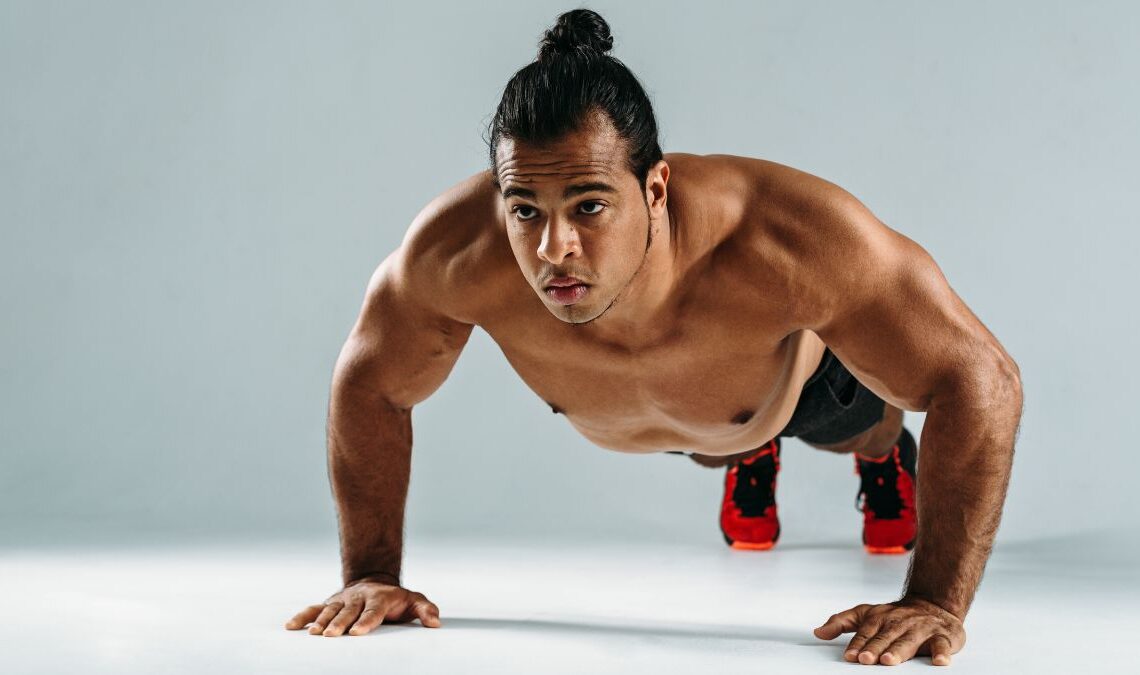Push-ups are a well-known and ubiquitous exercise. Its exalted position in the fitness sphere is fitting, as push-ups work several large muscle groups simultaneously. Push-ups are a multi-joint calisthenic movement that uses one’s body weight as resistance. They are also termed a closed kinetic chain movement.
This means that the furthest (distal) aspect of an appendage is fixed to an unmoving or stationary object. Exercises categorized this way may include push-ups, bicep curls, pull-ups, shoulder presses, lunges, and squats. These types of exercises are functional for everyday life, enhancing joint proprioception and stability of the joint to aid in superior form and muscle activation.
In fact, push-ups aid in building bone mass, increasing muscle mass, muscle endurance, and strength in the core, shoulders, and legs whilst also improving movement posture and providing a muscle booster. As it involves numerous joints and associated muscles, it offers a metabolic boon, making it a good cardiovascular exercise that can be implemented to support weight loss.
Jump Link
Muscles worked
Anatomically speaking, the muscles utilized during a push-up are categorized by what actions they perform. The agonist is the main moving muscle, and the antagonists are those that oppose the agonist in whatever movement is being performed. They are located opposite the agonist. The synergists are the helper muscles that assist the action of the agonist, and the fixators are those that provide stability to associated joints.
Agonist:
- Pectoralis major
Antagonist:
- Rhomboids
- Posterior deltoids
- Trapezius muscles
Synergists:
- Anterior deltoids
- Triceps brachii
Fixators:
- Core muscles
- Rotator cuff
- Latissimus dorsi
- Quadriceps
Primary muscles used
The push-up entails maintaining a rigid plank pose with toes firmly affixed to the ground, followed by a descension of the chest to the floor by bending the elbows and then returning to a plank. This movement requires the abdominals to be engaged ceaselessly throughout the movement.
It also puts a majority of the body weight on the muscles of the upper body. Please note that the muscles used are active in both the pushing (muscle shortening “concentric”) and lowering (muscle lengthening “eccentric”) phases, oscillating between flexion and extension. The primary muscles used while performing the push-ups include:
- Pectoralis major and minor: These are the primary muscles of the chest that are lengthened when the chest is lowered towards the floor and shortened or contracted when the torso is raised. Though push-ups work numerous muscles, it is inherently chest exercises.
- Triceps brachii: These are the three (the prefix “tri” denoting three) muscles at the back of the arm. While you descend, the triceps provide stability to the torso and contract when you ascend.
- Anterior deltoids: This refers to the front of the large round muscles at the top of the arm. These muscles are employed to stabilize the shoulder joint during the downward motion and help adduct or bring the arms towards the chest when ascending.
Accessory muscles
Other muscles are still necessary when performing a push-up but play a supporting role in the movement, such as:

- Core muscles: This refers to the muscles that provide support, stability and balance for the torso and spine. They are the muscles that comprise the abdomen and lower back. These core muscles include mainly the abdominus recti (six-pack) and transverse abdominus or those deep abdominal muscles that start at the ribs and wrap around the trunk towards the back and are vital at providing lumbopelvic stability.
- Quadriceps: These are the four large muscles of the thigh located at the front or anterior portion of the upper leg. These contract and are needed to keep the legs taut, straight, and parallel to the floor.
- Anterior serratus and latissimus dorsi muscles: The serratus muscles are small and overlap the upper ribs, helping stabilize and move the scapula or shoulder blades. The latissimus dorsi, colloquially termed your “lats,” run along the lateral sides of the upper back adjacent to the serratus muscles and have a similar stabilizing or fixating role for the arms and scapula.
Variations of the push-ups
Elevated legs push-up
As the name implies, the legs are placed on something that elevates the lower body above that of the upper body. This places more load on the upper body and, hence, makes it more challenging.
Diamond push-up
This movement is certainly harder to perform, and it puts greater strain on the triceps. The hand placement entails that the elbows are flared out and the hands make a diamond shape with both thumbs and index fingers pointed towards one another.
Narrow base push-up
This simply places the hands close to the breasts so that the arms graze the sides. This also enhances tricep recruitment.
Wide base push-up
Here, the hands are placed farther than shoulder-width apart to place more emphasis on the pectoral muscles.
Plyo push-ups
Plyometric push-ups are explosive, intense push-ups where power and momentum are created at the bottom of the push-up, followed by lifting both hands off of the floor simultaneously. This requires a lot of strength, power, and cardiovascular effort. The advanced version of this can include clapping one’s hands at the top.
T-Pushups
A t-pushup is executed by performing a standard push-up, followed by shifting one’s body weight unilaterally into a side plank and alternating sides.
These are advanced options, and if you are currently unable to perform a standard push-up, try performing one against a wall, on your knees, or by elevating your upper body to bear less weight on the hands.
Final thoughts
The push-up is a fixture of resistance exercise routines and with due merit. The push-up is a full-body exercise that is a functional, calisthenic movement that can be rehabilitative, strength building and cardiovascularly demanding. It can be performed virtually anywhere with no equipment needed and little space required.
The push-up can be modified or made more challenging as strength and fitness improves. Though it especially targets the pectoral muscles of the chest, it also works the deltoids and shoulders, the core muscles both deep and superficial, the muscles of the lower, upper and lateral sides of the back, as well as the triceps.





